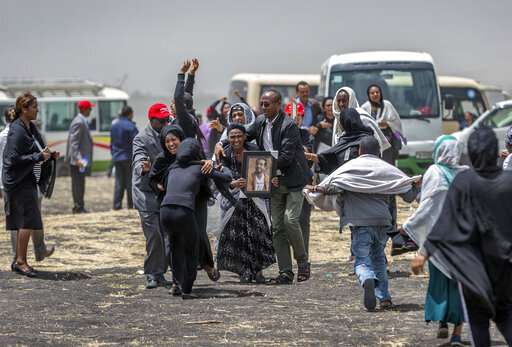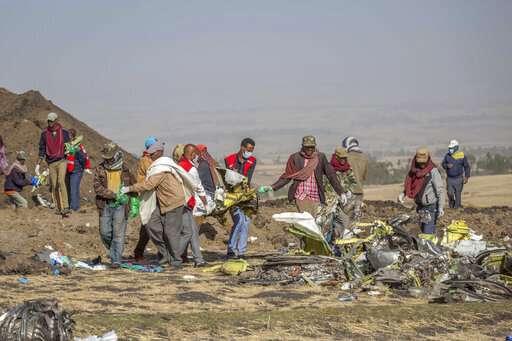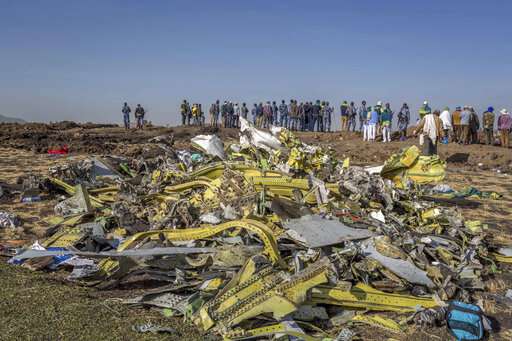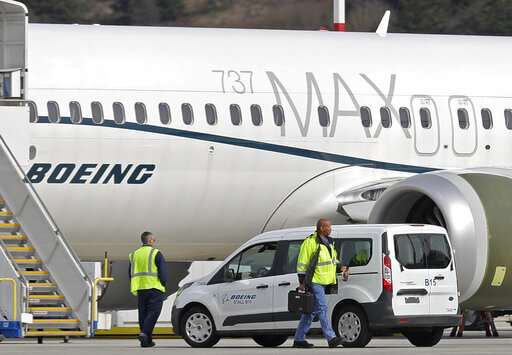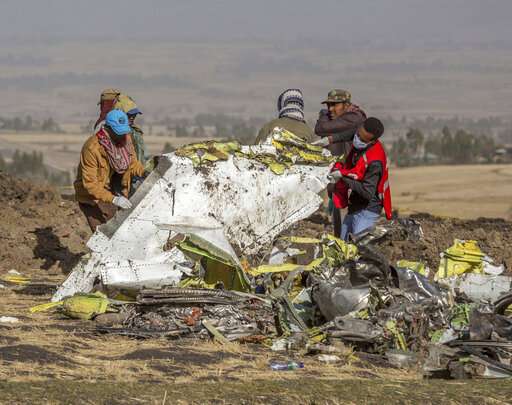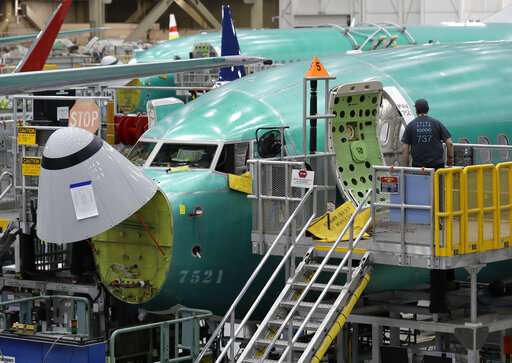In this Wednesday March 13, 2019 file photo, a grieving relative who lost his wife in the plane crash is helped by a member of security forces and others near Bishoftu, in Ethiopia, at the scene where the Ethiopian Airlines jet crashed just after taking off from Addis Ababa on March 10, killing all 157 on board. A preliminary report finds that the crew of the Ethiopian Airlines jet that crashed last month performed all the procedures recommended by Boeing but could not control the plane. (AP Photo/Mulugeta Ayene, File)
A doomed Ethiopian Airlines jet suffered from faulty readings by a key sensor, and pilots followed Boeing's recommended procedures when the plane started to nose dive but could not avoid crashing, according to a preliminary report released Thursday by the Ethiopian government.
The findings drew the strongest link yet between the March 10 crash in Ethiopia and an October crash off the coast of Indonesia, which both involved Boeing 737 Max 8 jetliners. All 346 people on the two planes were killed.
Both planes had an automated system that pushed the nose down when sensor readings detected the danger of an aerodynamic stall, but it now appears that sensors malfunctioned on both planes.
Thursday's report, based on flight data and cockpit voice recorders on the Ethiopian Airlines jetliner, showed that a faulty sensor on the plane touched off a series of events that caused the pilots to lose control of the plane. The report from Ethiopia's Aircraft Accident Investigation Bureau said the sensor problems began about a minute after the plane was cleared for takeoff.
It said air speed and altitude values on the left side of the 737 Max conflicted with data from the right sensor, causing flight control problems. Eventually the Ethiopian Airlines pilots couldn't keep the plane from crashing into the ground, killing all 157 people on board.
In this Wednesday March 13, 2019 file photo, relatives react at the scene where the Ethiopian Airlines jet crashed near Bishoftu, in Ethiopia, just after taking off from Addis Ababa on March 10, killing all 157 on board. A preliminary report finds that the crew of the Ethiopian Airlines jet that crashed last month performed all the procedures recommended by Boeing but could not control the plane. (AP Photo/Mulugeta Ayene, File)
The problems are similar to those reported on the Indonesian Lion Air flight that crashed last October. Investigators found that software on that plane took readings from the sensor and pointed the nose down. Thursday's revelations raise questions about repeated assertions by Boeing and U.S. regulators that pilots could regain control in some emergencies by following steps that include turning off an anti-stall system designed specifically for the Max, known by its acronym, MCAS.
Investigators are looking into the role of MCAS, which under some circumstances can automatically lower the plane's nose to prevent an aerodynamic stall. The Max has been grounded worldwide pending a software fix that Boeing is rolling out, which still needs to be approved by the U.S. Federal Aviation Administration and other regulators.
In a statement, Boeing acknowledged the faulty data from the sensor activated the MCAS system, which was similar to circumstances in the Lion Air crash.
The company said that to make sure unintended activation of the system doesn't happen again, Boeing is developing software and "associated comprehensive pilot training" for the Max. The software update, Boeing said in the statement, adds layers of protection and will stop erroneous data from activating the system.
Ethiopian investigators did not specifically mention the MCAS, but recommended that Boeing review "the aircraft flight control system related to the flight controllability." They also recommended that aviation officials verify that issues have been adequately addressed before allowing the planes to fly again.
-
In this Thursday March 14, 2019 file photo, Ethiopian relatives of crash victims mourn at the scene where the Ethiopian Airlines jet crashed near Bishoftu, in Ethiopia, just after taking off from Addis Ababa on March 10, killing all 157 on board. A preliminary report finds that the crew of the Ethiopian Airlines jet that crashed last month performed all the procedures recommended by Boeing but could not control the plane. (AP Photo/Mulugeta Ayene, File)
-
In this Monday March 11, 2019 file photo, rescuers work at the scene of an Ethiopian Airlines flight crash near Bishoftu, or Debre Zeit, south of Addis Ababa, Ethiopia. The Ethiopian Airlines jet crashed just after taking off from Addis Ababa on March 10, killing all 157 on board. A preliminary report finds that the crew of the Ethiopian Airlines jet that crashed last month performed all the procedures recommended by Boeing but could not control the plane. (AP Photo/Mulugeta Ayene, File)
-
In this March 11, 2019, file photo, wreckage is piled at the crash scene of an Ethiopian Airlines flight crash near Bishoftu, Ethiopia. A published report says pilots of an Ethiopian airliner that crashed followed Boeing's emergency steps for dealing with a sudden nose-down turn but couldn't regain control. (AP Photo/Mulugeta Ayene, File)
-
In this March 14, 2019, file photo, workers walk next to a Boeing 737 MAX 8 airplane parked at Boeing Field, in Seattle. A published report says pilots of an Ethiopian airliner that crashed followed Boeing's emergency steps for dealing with a sudden nose-down turn but couldn't regain control. (AP Photo/Ted S. Warren, File)
-
In this Sunday March 10, 2019 file photo, family members of the victims involved in a plane crash react at Addis Ababa international airport. The Ethiopian Airlines jet crashed just after taking off from Addis Ababa on March 10, killing all 157 on board. A preliminary report finds that the crew of the Ethiopian Airlines jet that crashed last month performed all the procedures recommended by Boeing but could not control the plane. (AP Photo/Mulugeta Ayene, File)
-
In this Wednesday March 13, 2019 file photo, a family member reacts at the scene where the Ethiopian Airlines jet crashed near Bishoftu, in Ethiopia, just after taking off from Addis Ababa on March 10, killing all 157 on board. A preliminary report finds that the crew of the Ethiopian Airlines jet that crashed last month performed all the procedures recommended by Boeing but could not control the plane. (AP Photo/Mulugeta Ayene, File)
At a news conference, Minister of Transport Dagmawit Moges said the Ethiopian Airlines crew "performed all the procedures repeatedly provided by the manufacturer but was not able to control the aircraft."
However, it wasn't clear whether the Ethiopian pilots followed Boeing's recommendations to the letter in dealing with the system repeatedly pointing the nose down.
The pilots initially followed Boeing's emergency steps by disconnecting the MCAS system, but for an unknown reason, they turned the system back on, an official familiar with the crash investigation told The Associated Press on Wednesday, speaking on condition of anonymity because investigators had not yet released their preliminary report. Boeing's procedures instruct pilots to leave the MCAS system disconnected and continue flying manually for the rest of the flight.
Ethiopian investigators did not address that issue at Thursday's news conference, saying only that the pilots had done what they were supposed to.
Family members of crash victims said they were unsettled by the report's findings.
In this March 11, 2019, file photo, rescuers work at the scene of an Ethiopian Airlines flight crash near Bishoftu, Ethiopia. A published report says pilots of an Ethiopian airliner that crashed followed Boeing's emergency steps for dealing with a sudden nose-down turn but couldn't regain control. (AP Photo/Mulugeta Ayene, File)
"Today's preliminary report suggests Boeing could have done better in notifying the problem with the aircraft system early on," said Konjit Shafi, who lost her younger brother, Sintayehu Shafi, in the crash. "This is causing us a great deal of pain. It is so sad to learn that our loved ones would have been spared if this problem was detected on time."
"We want justice, not a delayed justice but a quick one. I heard the full report may take one year. But that's too long," she said, surrounded by her family members in Ethiopia's capital, Addis Ababa.
Meanwhile, the family of a 24-year-old American woman killed in the crash sued Boeing on Thursday. The complaint, which also names Ethiopian Airlines and parts maker Rosemount Aerospace as defendants, alleged negligence and civil conspiracy among other charges.
"Blinded by its greed, Boeing haphazardly rushed the 737 MAX8 to market" and "actively concealed the nature of the automated system defects," the lawsuit filed on behalf of the family of Samya Stumo alleged. Stumo is a great grand-niece of consumer advocate Ralph Nader.
Nader called on consumers to boycott the 737 MAX 8 and blasted the FAA for delegating so much responsibility in certifying the plane was safe to Boeing.
In this March 27, 2019, file photo, a worker enters a Boeing 737 MAX 8 airplane during a brief media tour of Boeing's 737 assembly facility in Renton, Wash. A published report says pilots of an Ethiopian airliner that crashed followed Boeing's emergency steps for dealing with a sudden nose-down turn but couldn't regain control. (AP Photo/Ted S. Warren, File)
"Those planes should never fly again," Nader said. "If we don't end the cozy relationship between the patsy FAA ... and the Boeing Company, 5,000 of these fatally flawed planes will be in the air all over the world with millions of passengers."
Boeing is the focus of investigations by the U.S. Justice Department, the Transportation Department's inspector general, and congressional committees. Investigations are also looking at the role of the Federal Aviation Administration in the U.S., which certified the Max in 2017, and declined to ground it after the first deadly crash in October. The agency was also reluctant to ground the planes after the Ethiopian Airlines crash and was among the last agencies to do so.
The FAA, which must certify the 737 Max is safe before it can go back into the air, said in a statement that the investigation is still in its early stages.
"As we learn more about the accident and findings become available, we will take appropriate action," the agency said.
© 2019 The Associated Press. All rights reserved.


